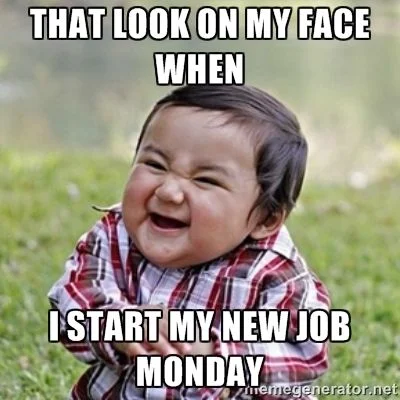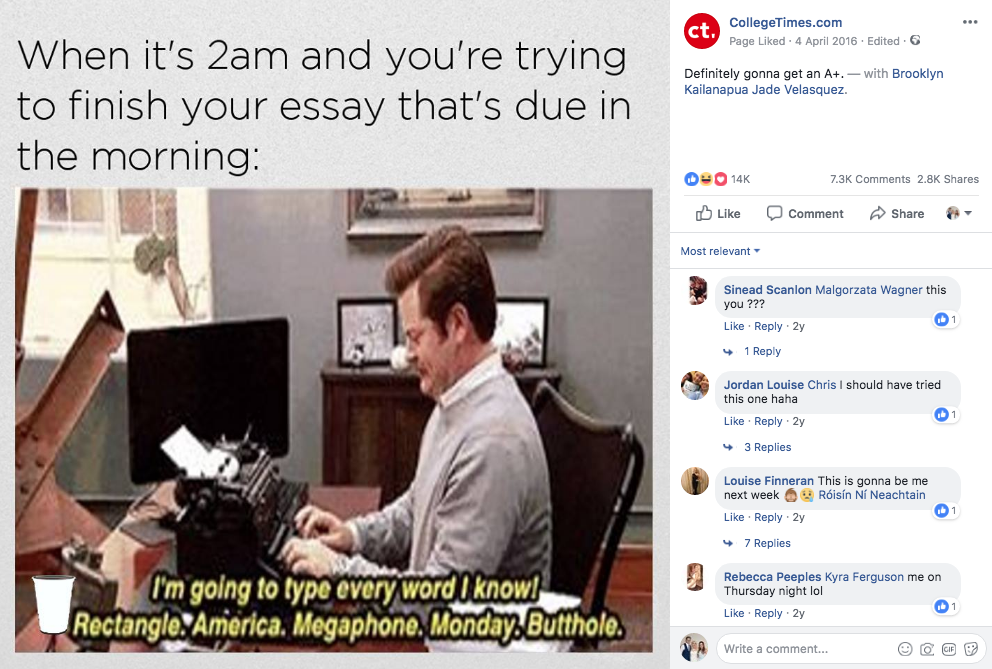The Life Of A Full Time Meme Maker
A meme is defined in the Oxford Dictionary as:
“An image, video, piece of text, etc., typically humorous in nature, that is copied and spread rapidly by Internet users, often with slight variations.”
When I graduated from Maynooth University in Media Studies in the September of 2015, I had aspirations of landing a dream job in media. What I couldn’t have predicted was that within a few months, I’d be making memes full time (so it pretty much came true). An opportunity came my way when someone posted about a job vacancy as a “Content Creator” on a media graduates Facebook group. Although I didn’t know what a content creator was at the time, I didn’t let that stop me and applied for the job. After putting together some fairly ropey photoshop samples (Youtube tutorials can teach you anything), I interviewed for the role and started creating content for CollegeTimes and TeenTimes the following week.
CollegeTimes were like Ireland’s answer to LADBible back in 2015 and TeenTimes was similar to publishers like Pretty52 but aimed predominantly at a teenage female audience. For anyone unfamiliar with how publishers operate on social media platforms, here's a quick run down of how they become profitable;
They identify an audience on the web and social media
They engage that audience with content (videos, images, blog posts etc)
They convert this new audience into a loyal following through future content and competitions making them more susceptible to seeing their future posts and ads
They run sponsored ad campaigns to promote their own brand/merchandise or affiliated products/brands to this audience through articles/targeted ads etc. This is then scaled up and the profits become greater
Social networks themselves generally work to an ever changing algorithm that ranks posts on your timeline based on your likes, characteristics, behaviours on the platform and the activity of your close friends. Publishers take advantage of these algorithms and deliver content that focuses solely on share-ability. This means that it’s not enough for a user to simply "like" their content, they must either comment underneath it or share it on their own timeline to give it greater reach.
If this content is then directly shared by other popular pages and influencers, it accelerates the reach of both this piece of content and thus your online brand. Publishers make their money by consistently pumping out content like this and being in a constant state of “virality” (I don’t think that’s even a word….yet) among their audience.
Although most of the above will be obvious to anyone who spends time on social media, my role involved sharing viral videos, articles from our team of writers and creating my own memes (9 a day!) to build our following at a relentless pace. This may sound easy but I am about to take you on a journey into the dark corners of the meme world. This piece isn't meant as an exposé on other full time meme makers but I am about to lift the lid on the whole industry (kinda).
Generally, as a meme maker, you work off trending topics, pop culture imagery and current affairs to put together a fresh idea that then becomes your meme. Unfortunately, when you’re trying to churn out 9 memes a day, this isn’t always realistic. To combat this, I’d routinely scan Reddit, Twitter, Facebook and Instagram to spot where that perfectly relevant meme was just waiting to be discovered. Once discovered, I’d redesign it and add our logo. Some would call this process stealing, I called it inspiration so I could sleep at night.
This is common place in the meme world and by the time any meme has really gone viral, it’s original source becomes insignificant. Once out there, it belongs to the ether of the web and is destined to float there in it’s multiple forms for eternity. In many cases, we would find that some of our most popular memes would appear on larger or smaller pages with similarly high levels of engagement. It was kill or be killed!
Enough of the blabbering, it’s time to let some of my finest work do the talking. TeenTimes was a publisher aimed mainly at teen girls from the ages of 12 and 18. Content for this page was mainly related to things like BFF’s, fairy light room decorations, Gossip Girl and Channing Tatum. These topics (as stereotypical as they may sound) were almost a sure fire bet when it came to getting those likes, shares and comments.
When it came to the memes specifically, TeenTimes already had a distinctive design for their memes which they called the "Emoji Memes”. Michael Breen, a student intern from DCU at the time, initiated me into the world of Photoshop as we began to design and share masterpieces like the below on a daily basis;
The sad fact that I was a 23 year old man designing memes like the above all day was not lost on me. The experience did teach me a lot about social media though. Why that meme did so well (386,000 shares) was because it spoke to that audience in a way that encouraged them to tag their friends or share it out on their own pages. The page did already have over 1,000,000 followers at the time but that level of organic engagement for a single post is still incredible.
Facebook has since hindered publishers and brands massively when it comes to organic reach but the above still illustrates how even the simplest pieces of relevant content can stimulate engagement. When you share content like this consistently, then “pennies make pounds” and your page reach and thus awareness snowballs. Below are two more of my tragically cringe worthy TeenTimes memes that further illustrate this point but are also just great to laugh at (my captions are particularly priceless).
College Times on the other hand had a smaller audience of around 280,000 fans when I began to create content for that page. With the help of a great team of content writers producing blogs and my ever increasing meme powers, we began to push the reach of the page to new heights. Identifying that the audience for this page was more about skipping lectures to go on the rip than their younger TeenTimes counterparts, we focused our content on exactly that.
Again, I’d like to note that personally I never really found any of these memes to be clever or funny, I just knew by looking at them that they would get the engagement levels we were after. Below are just two examples of the types of memes we would share on CollegeTimes;
The beauty of the meme game is that even when you feel like you have it worked out, there’ll always be a surprise waiting for you. My surprise came on the day of May 7th, 2016. Having arrived into work to review my previous days memes and reply to any of the top comments, I was shocked to see that one I hadn’t really thought much of had began its viral journey to an unprecedented 80,000 likes, 67,000 comments and 25,000 shares.
Now I’m not a mathematician but if you account for the way the algorithm on Facebook worked at that time, I’m gonna say this post alone reached more eyeballs than the World Cup Final in Brazil the summer before. This is still a meme that I see regularly pop up in random corners of the internet and I always give it a quick like to keep it going on its way.
I didn’t only make earth shattering memes during this period of my career, I also got the opportunity to create promotional posters, feature images for blog posts and most memorably a recruitment poster aimed at writers in the summer of 2016. While brainstorming how we could do something different with this poster, I scanned the internet again for inspiration. After a couple of minutes, I opted for a nod to the then clown like figure who was always in the news during his laughable attempt at becoming the president of the USA.
Sadly for me, as quickly as I had gotten a foothold in the meme world, my foray into social media virality (I will make it a word) was to end. The company that managed both pages was sold in the middle of 2016 and I had to give up the meme dream. I did learn a lot from my time as a professional meme artist and the experience has honestly been a great basis for my work in digital marketing since.
Memes will always be around in some way or another online as long as there is content that engages people and their inherent need to share it with others. Marketers and brands should always operate on this basis when their posting to social media platforms in particular. If you’re not putting out consistent content that people will enjoy (videos, images etc), then how can you expect them to listen when you’re giving a more commercial sales pitch?
If you’re looking to boost your own brand through content marketing or just looking for someone to talk to about your meme addiction, get in touch with me here. You can also follow me on Instagram and Facebook.









